#Digital Library Reading App for kids
Explore tagged Tumblr posts
Text
things you can find at your library!
not exhaustive and not applicable to all libraries but i wanted to share my handy little list. libraries are such great community spaces and there's so much more to them than meets the eye. as always, i would love to hear what your library has going on!
BOOKS! this is the obvious one. most libraries have fiction, non-fiction and plenty for kids from their first books through to ya. many libraries have a large print section as well.
audiobooks! libraries can have cds but also plenty of audiobooks that you can access digitally.
ebooks! with a library membership, you can use apps such as libby and overdrive to read books that may not otherwise be accessible.
free sanitary products! they usually carry tampons and pads of various sizes from nonprofit organisations.
computers! if you're seeing this, you probably have internet access but if for any reason you are unable to use your devices, library memberships usually include access to their pcs.
activities for kids! a lot of libraries have arts and crafts or weekly sessions where kids of all ages can enjoy reading challenges, stories and singing.
activities for adults! local groups for anything from sports to music use library spaces. your library may also have a board where events and clubs are advertised.
support for locals! libraries are lovely spaces that welcome everyone. chances are, your local library can help you get the support you need. i've seen libraries provide help for everything from mental health to immigration documentation.
libraries are such a great resource that i really encourage you to make the most of. show some love to your librarians!!! they really do so much for their communities
15 notes
·
View notes
Text
Library Rules:
To quote Davy Jones "well they're more guidelines than rules".
What I've learned in time (thus far) working as a librarian and what you can do as a patron.
If you want the TLDR: you can just read the bolded stuff if you want! :)
I swear to god you're allowed to do everything in a library normally if you don't have a library card. The only thing you're not allowed to do is take items home with you. So what can you do instead? Read it here. Watch the movie here (most of the time the people who work here will let you have a guest pass for the computer, and then don't ask you what you're doing with your time on the computer.) (unless you're watching porn. Don't watch porn on a public computer because we will kick you out for the day minimally.)
Come to a Program! Again you do not need a library card to come to our programs. They're chill, they're Gucci. We have so much fun stuff for you to do here. And it's FREE. (To the one person who might see this and be like "BUT MY TAXES!" yeah, your taxes paid for this, why aren't you utilizing the library? Why don't you have your library card? Why aren't you coming to my sick sick writing programs, or my awesome D&D programs?)
Children say odd shit. I had one kid tell me as he was sprinting to a computer, while holding a guest pass to be able to log onto the computer, "I'm gonna shove this up your bootyhole!". He said that verbatim, and honestly respect kid. but also like, hey, I'm just helping you get on the computer, relax. Also if you're going to be working consistently with kids/teens (like me), they're hilarious and are usually much more understanding than the adults.
Every library is different when it comes to creating a program. We have to normally plan months in advance to be able to do something. At the library I'm at we're planning for programs three months ahead while currently running our November Programs.
You can ask questions that you think are stupid. They're not. I promise they're not. I have had people ask me if they can have a sticker while looking at the sign that says "free stickers!!!! HERE!!" Most of the time we'll probably want to research your question and get stoked (or at least I will) by being able to research about whatever you're interested in. (Please ask us what we like to learn about in our free time.)
Sometimes, the book is checked out, because someone got to it before you. Them's the breaks man, we can't go to the person who check it out, and ask them to check it back in so we can check it out to you. However, we can put you on the list to be able to read it next. WITH YOUR LIBRARY CARD. Please get a library card. Can you tell how super chill I am about getting a library card?
Fun Fact! A lot of libraries will let you have temporary library cards. For example you can get a New York Public Library digital card (a temporary one) for 2-3 weeksish before having to go in and getting a physical card. So use it for the couple of weeks! Listen to an audio book!
Another one! I have so many. I'm sorry. You do not need an Audible subscription to be able to read eBooks or listen to Audiobooks on your phone. Use Libby! Just input your library card on the app, and use it like a regular library card. You have to wait until it's your turn (like physical copies of library materials), and then you have the 2-3 weeks to be able to listen to your stuff or read your eBook! And if your library does Hoopla, it's basically the exact same as Libby, however it's only 8 items rather than however many you can check out at once on a library card. Hoopla is a bit more convoluted than that, but if you want to know more just ask!
That's all I got right now. Sorry for the long post. :')
#library science#just wandering here#librarian#the librarians#books & libraries#come to your local library#local library#books and reading#books and libraries#library programs#what can i do now#wtf is going on#ridiculous#i got this#if i got nothing i at least have this#kids say the funniest things#kids say the darndest things
5 notes
·
View notes
Note
hi!! I saw your post about the national library card from I think you said a library in Seattle?? I’m trying to get back into reading and this sounds super cool so I’m wondering how you did that and how it connects to libby! (I don’t have libby, so another question is do you like/recommend libby?) thanks!!
this is such an awesome ask to receive hihihi first of all i wanna say i'm also trying to get back into reading rn and libby is making it so much easier for me! listening to audiobooks at work i've already read more books in 3 months than all of last year. i'm not even sure which post you're coming from bc i've been making lots of excited posts about discovering new options lol
so the seattle thing i referenced is the books unbanned program the seattle public library is involved in and i recently reblogged a post listing several other libraries also involved, basically offering access to their digital library to anyone in the US (within a certain age group, but i'm hoping it's fudgeable?). i'm hoping you're in the US, idk how it works elsewhere
all i did was sign up for a card and i got an email with a card number which is good for a year! i'm still discovering this myself, so i haven't looked at any of the others or properly explored the options on the SPL website yet (on top of libby access they have their own online library!) i imagine the cards from the other libraries probably work the same way.
libby is an app for accessing ebooks and audiobooks through your public library. it's kind of the 2.0 version of overdrive, if you're familiar w that, from which it took over. you search up your library in the app and input your card number/account info and tada! access to whatever catalog your library has!
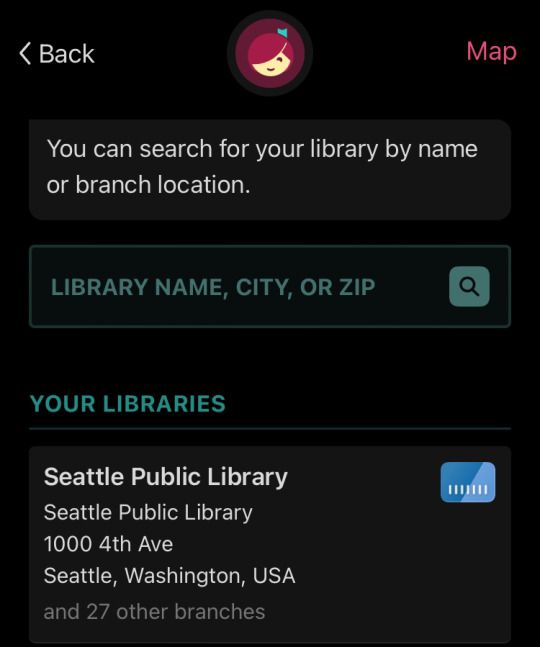
i would absolutely recommend libby, it's pretty easy to use, you can make custom lists of books with their 'tags' feature (i have a list i know i want to check out, one i want to take a second look at called "hmm," and one just called "whoa what" just for a collection of remastered old radio plays(?!))
i figured i'd try plugging the SPL card and was happily surprised to find it worked! i have two cards added rn, my local lib has a borrowing limit of 5 items at a time and SPL has limit of 10, and they both have a hold limit of 10. SPL has a way huger catalog than my local, and while the waitlists are longer, they have more copies(/digital lending licenses or whatever). it was so exciting to find all the new stuff that i hadn't had available before!
(i would check your library website to see what digital resources they offer and are connected with. i think libby is nearly universal? i've also used kanopy, which has tv and movies (my library had this one a couple years ago but i couldn't log back in recently i think they ended whatever subscription they had) and hoopla, which has books, audiobooks, comics, comics adapted into audio format, tv series, movies, music, sheet music,,,! and you get 10 borrows a month plus wvr bonuses they're currently offering. i love hoopla a LOT. i haven't had luck accessing those two using my SPL card, though. my library is also listing freegal for music and another couple services for specifically kids' books)
please feel free to ask me more questions if i didn't answer to your satisfaction, i got overexcited
#sunlit-sonata#asks#eta: i actually cant get anything on libby on my local lib side atm bc i currently have several overdue physical items....#but i'm gonna return them it'll be fine
6 notes
·
View notes
Text
Empowering Home-Based Learning: A Comprehensive Guide to Educational Resources for Kids

Empowering home-based learning can be an enriching experience for both parents and children. With the abundance of educational resources available online, you can create a comprehensive and engaging learning environment for your kids.
Here's a guide to help you navigate the vast sea of educational tools and materials:
1. Online Learning Platforms:
a. Khan Academy: Offers free online courses, lessons, and practice in various subjects.
b. Coursera for Kids: Provides courses from top universities on a wide range of topics suitable for children.
c. edX for Kids: Offers high-quality courses from universities and institutions around the world.
2. Interactive Learning Websites:
a. ABCmouse: A comprehensive early learning academy for children aged 2-8.
b. PBS Kids: Provides educational games and videos based on popular PBS shows.
c. Starfall: Focuses on reading, mathematics, and phonics for young learners.
3. Educational Apps:
a. Duolingo: A fun language learning app suitable for various age groups.
b. ScratchJr: Introduces young children (ages 5-7) to programming concepts through coding.
c. Epic!: A digital library with a vast collection of e-books for children.
4. STEM Resources:
a. NASA Kids' Club: Offers games, activities, and information about space exploration.
b. Mystery Science: Provides open-and-go lessons for elementary school children.
c. National Geographic Kids: Educational resources on science, geography, and more.
5. Virtual Museums and Tours:
a. Google Arts & Culture: Allows virtual exploration of museums and cultural landmarks.
b. Smithsonian Learning Lab: Offers access to millions of digital resources from the Smithsonian's collections.
6. Educational YouTube Channels:
a. SciShow Kids: Makes science accessible and fun for young learners.
b. National Geographic Kids: Features videos about animals, science, and geography.
c. TED-Ed: Provides lessons worth sharing on a variety of subjects.
7. Educational Games:
a. Prodigy Math Game: Makes learning math engaging through a game-based platform.
b. BrainPOP: Offers educational games on various subjects.
c. Funbrain: Provides interactive games focused on math and reading skills.
8. Coding Resources:
a. Code.org: Features free coding lessons and activities for kids.
b. Tynker: Introduces coding through interactive games and projects.
c. Scratch: A visual programming language that makes coding accessible to children.
9. Printable Worksheets and Activities:
a. Education.com: Offers a wide range of printable worksheets for different subjects and grade levels.
b. Super Teacher Worksheets: Provides resources for math, reading, writing, and more.
c. Teachers Pay Teachers: A platform where educators share and sell their educational resources.
10. Library Resources:
a. Libby/OverDrive: Allows access to a wide range of e-books and audiobooks from local libraries.
b. Storyline Online: Features videos of actors reading children's books aloud.
11. Parent-Teacher Collaboration:
a. Seesaw: Enables communication and collaboration between parents and teachers.
b. ClassDojo: Connects teachers, students, and families to share updates and communicate.
12. Adaptive Learning Platforms:
a. IXL: Offers personalized learning in math, language arts, science, and social studies.
b. DreamBox: Focuses on math education with adaptive learning technology.
13. Mindfulness and Well-being:
a. Headspace for Kids: Introduces mindfulness and meditation practices for children.
b. GoNoodle: Provides movement and mindfulness videos to promote physical activity and well-being.
14. Educational Podcasts:
a. Brains On!: A science podcast for kids and curious adults.
b. But Why: A Podcast for Curious Kids: Addresses questions submitted by young listeners.
15. Parental Controls and Safety:
a. Common Sense Media: Offers reviews and recommendations for age-appropriate content.
b. Kid-friendly Browsers: Consider using kid-safe browsers like KidzSearch or Kidoz.
Tips for Effective Home-Based Learning:
1. Create a Schedule: Establish a daily routine to provide structure.
2. Encourage Exploration: Let your child explore topics of interest.
3. Balanced Screen Time: Monitor and balance screen time with offline activities.
4. Engage in Activities Together: Participate in learning activities to make it more enjoyable.
5. Foster a Love for Learning: Celebrate achievements and foster a positive attitude toward learning.
Remember, the key is to adapt these resources to your child's learning style and interests. Each child is unique, so feel free to experiment and tailor your approach to what works best for your family.
READ FOR MORE INFO SO PLEASE CLICK HERE AND VISIT OUR MAIN WEB PORTAL
#Babylistwelcomebox#Educationalresources#freehomeschoolcurriculumforautism#freelessonplans#homeschoolresources#homeschoolwebsites#lessonplan
2 notes
·
View notes
Text
Please take on a library membership if you do not already have one! They're so good for so many reasons, and this is part of where your taxes are going, utilise and enjoy it.
If you live in an area with multiple speciality libraries -academic, state, public, toy, specialist, national - get one for as many as you can, the conditions are usually not what you expect, and they have to make it accessible to continue access funding to continue supplying the public with resources and services. You often can apply online, and get started with digital resource access straight away!
If you live in an area with a "one card" network, you can access DOZENS of libraries, and often they are connected for their patrons with a specialised courier inter-library loan service, for free (or cost if interstate/at a library not connected to the network), meaning if you borrow or request something at one library, you can return or pick it up at another.
They're online! They're in apps! They have community groups like baby storytime for all caregivers, and craft workshops, and literacy/ information technology -often geared towards users who want to be more familiar with modern computer software or work on their job seeking documents/steam workshops, usually for free!
Soooo many have Lego/Minecraft/coding programs now toooooo.
Good ways to meet people (or just be around people without a lot of actual intentional interaction - I am geared this way, predominantly), good for young children's budding social skill growth in safe approachable environments (as well as their book loving journeys, always pleasure read to your kids, it's crucial for their development, as a learner and a well rounded human), learn new things and meet your community in a safe way!
Heck, it's a safe place for everyone to just hang out when you need to. The books are always grounding and it's easy to hide in the stacks when you need a minute or hour to compose yourself in public. They have free public bathrooms. They can often help refer you to related social services in hard times, help steer you to fresh perspectives in topics, and are a great way to just wander around as see the evidence of connectivity in subject matters, because of subject keytagging and easily accessed resources.
Some have allied toy libraries, tool libraries, audiobook collections, all the latest graphic novel series and manga that is sooo expensive for the average tween, teen and manga aficionado these days.
They have play areas for children, often have hot beverage kiosks or shops in or near their bounds, with accompanying soft and comfortable seating.
They offer extremely low cost service for copying, faxing, printing.
Lordy, I could go on and on. Even if you don't consider yourself a reader. Even if you have the means to access most resources through your own affluence or prosperity, get a membership. Sometimes those things don't last. Sometimes they do but you can help bump up numbers for funding. If you are in any way shape or form community minded, please consider getting a library membership.
Libraries and the people who fight for and love them are awesome. Librarians are some of the most punk rock awesome people in a nine to five skin suit you will ever meet (I have met exactly two horrid librarians in my career and current body's lifetime, and boy did I enjoy messing with them as a trickster library pro on those days. These two hadn't learnt how to not judge a book by it's cover. Sillies.)
This post brought to (a location near a library somewhere near) you by an entirely proud and very biased Librarian.
As a former librarian I'm actually required to remind you that many libraries that subscribe to Libby are opted into a program that lets you subscribe and access magazines for free with no wait

And that this is actually a really fun, low cost way to not only access news and larger cultural magazines, but also to get free patterns for many different crafts that you can screenshot if need be and that lower the financial barriers to entry for trying new things


From my experience working in both academic and public libraries, many libraries are use it or lose it funding-- I have to say this because a lot of patrons feel guilty for how much they use the library and how often they're using it funny enough, but the worst thing you can do for libraries is not try out new features and not use what's already given to you as much as possible.
The numbers that come as a result of your patronage are how most libraries justify their continued existence in times of financial hardship, which sucks but, go check out some magazines on Libby!
26K notes
·
View notes
Text
Kids Book AI Review – Create Hyper-Engaging Talking Kids Books In Any Topic
Welcome to my Kids Book AI Review. In a world rapidly driven by AI technology and digital transformation, content creation for children has taken a major leap forward. Whether you’re an educator, parent, entrepreneur, or digital product seller, the need for high-quality, engaging, and educational kids’ content is now more critical and competitive than ever.
Meet Kids Book AI, a revolutionary platform that empowers anyone to generate talking storybooks, animated books, educational puzzles, rhymes, and more, in any language and on any topic, in just a few clicks.
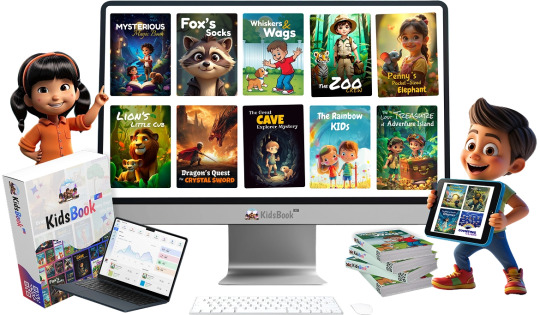
In this in-depth Kids Book AI Review, we’ll discuss what makes this AI-powered tool so magical, how it works, its key features, pricing, real user feedback, pros and cons, bonuses, and whether it’s the right solution for you.
What Is Kids Book AI?
Kids Book AI is an advanced artificial intelligence-powered content creation platform specifically designed to generate children’s storybooks, rhymes, activity books, educational puzzles, talking books, and animated books from just a single keyword or prompt.

Whether you’re a parent wanting to create bedtime stories, a teacher preparing learning material, or a marketer selling low-content books on Amazon KDP Kids Book AI offers a drag-and-drop, no-code platform to create fully personalized children’s content in seconds, not hours.
Kids Book AI Review – Overview Of Product
Product Creator: Dr. Amit Pareek
Product: Kids Book AI
Front-End Price: $37 One-Time Payment!
Official Site: Click Here To Visit Official FE Salespage
Kids Book AI Bundle: Click Here To Bundle Page
Product Type: Tools and Software
Support: Effective and Friendly Response
Recommended: Highly Recommended
Bonuses: YES, Huge Bonuses
Skill Level Required: All Levels
Refund: YES, 30 Days Money-Back Guarantee
Kids Book AI Review – About Developer

Kids Book AI was developed by Dr. Amit Pareek, a well-respected figure in the digital marketing space. As a seasoned entrepreneur and software creator, Dr. Pareek has a proven history of building powerful tools designed to help individuals grow their online businesses with ease.
Over the years, he has launched numerous best-selling products that have received outstanding feedback from users. Some of his most recognized releases include Ghibli, Humanizzer, GPT Apps Engine™, Ai Interactive Books™, MAVAS, QuickFunnel, MaxMailz, AcademyPro, Kaptiwa, and many others.
Thanks to his reputation for delivering high-quality, reliable software, you can trust that any tool created by Dr. Pareek — including Kids Book AI — is built to provide real value and results.
Kids Book AI Review – Key Features
Turn Any URL, PDF or Keyword into Interactive Kid Books
AI-Powered eCovers & Mock-ups
Inbuilt Content Creator
Interactive Narration with AI Voice & Text Highlighting
Done For You 3D Kids Icon Library
Done For You Background Templates
Embed Interactive Kid books on Any Website or Landing Page
Add CTA Buttons, Lead forms on Your Books
Add Videos, GIF, Images on Your Books
Drag & Drop Books Editor
Make your Books Public or Password Protected
Get QR Code Ready to Share Books
Flipbook & Tablet-Style Reading Modes
Convert Any PDF into FlipBooks
Create Book Albums from Images
Custom Domain to Publish Books on your own Branding
Built-in AI Content Enhancer & Smart Editor
One-Click Social Sharing to Top Platforms
White Label License to Kidsbook
Download, Share & Publish Books
Stunning In-Built Book Cover Designer
20 Million+ Stock Images Library
Commercial License Included
24×5 Dedicated Customer Support
30-Day Money-Back Guarantee
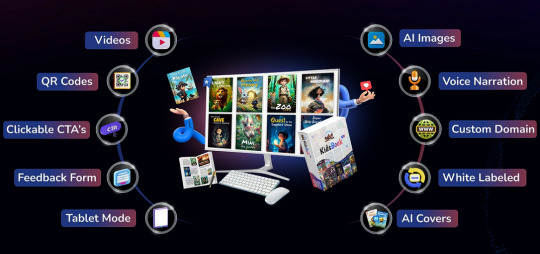
Kids Book AI Review – How Does It Work?
Just 3 Simple Steps to Launch Your Own Kids Book Empire
Step #1: Sign Up & Login
Simply log in using your credentials and unlock the full power of this next-gen Kids Book Creator. No tech skills or setup needed—you’re in!
Step #2: Create
Enter a URL, keyword or Upload your PDF and let the AI work its magic! Instantly create: Talking Storybooks, Animated Books, Cartoon Adventures, Animal Tales, Math, Science & Learning Books, Rhyming & Puzzle Books and so much more… all in under 60 seconds!
Step #3: Publish and Sell
Now you’re ready to go big! Sell your books on platforms like: Amazon KDP, Apple Book, Etsy, eBay, Kobo, Barnes & Noble, Keep 100% profits—no 3rd party subscriptions, no hidden fees, and no large investments needed. This is your moment to cash in on the booming kids content market—starting today!
Kids Book AI Review – Verify User Opinion
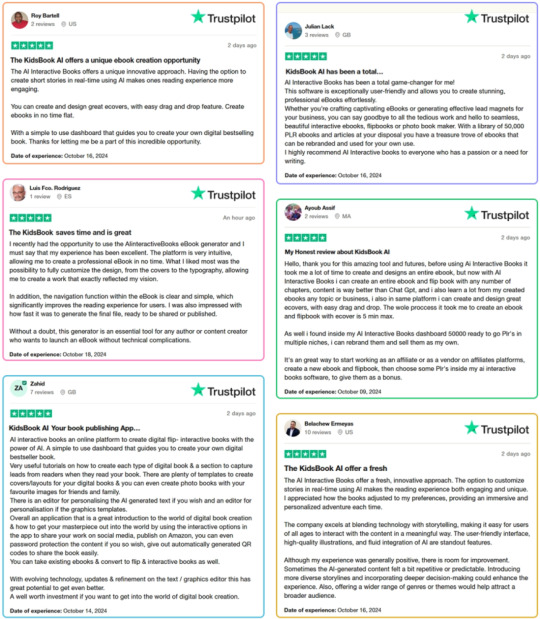
Kids Book AI Review – Who Should Use It?
Bloggers
Affiliate Marketers
Coaches and Consultants
Marketing Agencies
Entrepreneurs
Authors
Book Writers
Course Creators
Publishers
eCommerce Store Owners
Real Estate Agents
Digital Marketers
Consulting Firms
Event Organizers
Corporate Trainers
Influencers
Non-Profits
Startups
Health & Fitness Coaches
Financial Advisors
Kids Book AI Review – OTO’s And Pricing
Front-End (FE): Kids Book AI Commercial ($37)
OTO1: Kids Book AI Elite ($67)
OTO2: Kids Book AI Enterprise ($47)
OTO3: Kids Book AI Done For You ($47)
OTO4: Kids Book AI Traffic ($37)
OTO5: Kids Book AI Agency ($97)
Kids Book AI Review – Pros and Cons
Pros:
Fast content creation (60 seconds or less)
Supports 100+ languages
Realistic AI voiceovers
Custom illustrations and layouts
Includes puzzle and rhyme generators
Commercial license included
Global publishing potential
No software installation (100% cloud-based)
Regular monthly updates included
Cons:
Requires a one-time Payment
Limited offline functionality (requires internet)
Nothing wrong with it, it works perfectly!
Kids Book AI Free Exclusive Bonuses
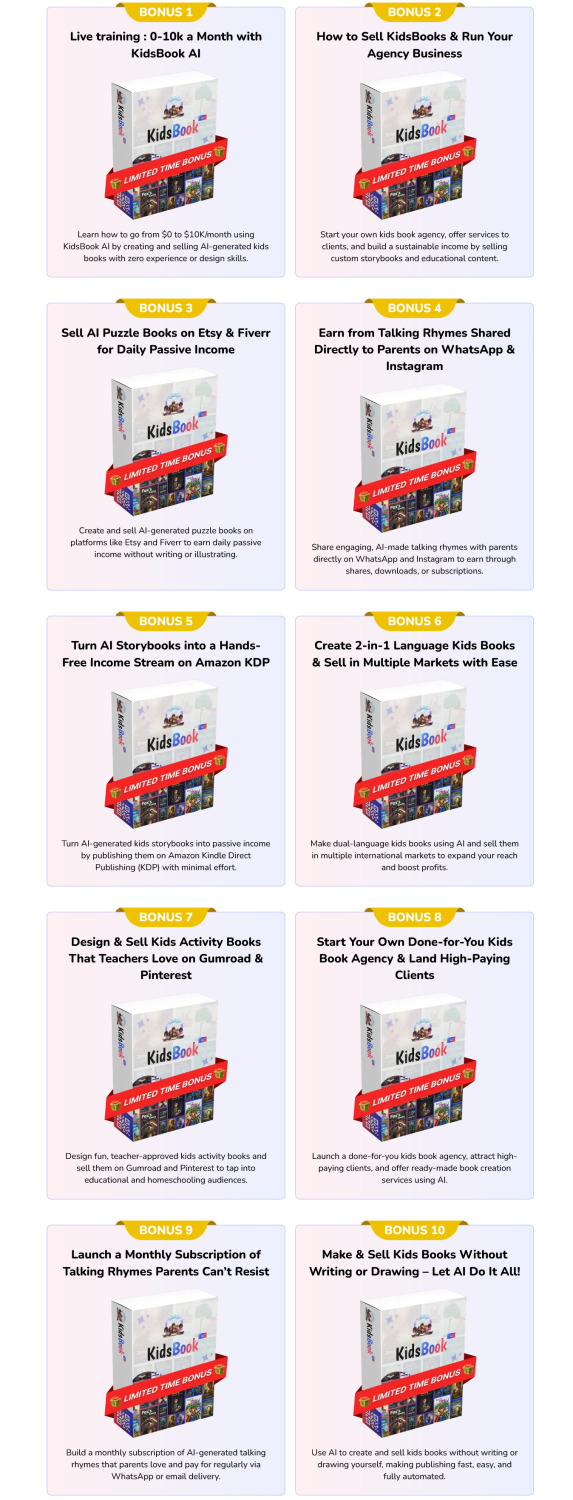
Kids Book AI Review – Frequently Asked Questions
Q1. Do I need to download or install Kids Book Ai?
No, Kids Book Ai is fully web-based. Just create an account, and you can start using it online across all browsers and devices, including Windows and Mac—no downloads required.
Q2. Is my investment risk-free?
We take your investment seriously. While there’s no “no questions asked” refund policy, you can request a refund with a valid reason and proof that you’ve tried the platform.
Q3. Is Kids Book Ai compliant with guidelines and regulations?
Yes, we follow all prescribed guidelines and make regular efforts to stay compliant. However, for third-party integrations, we advise reviewing their terms before using them with Kids Book Ai.
Q4. What does “lifetime” mean?
The “lifetime” refers to the product’s active support and functionality, which is estimated to be around five years.
Q5. How many credits do I get with the Front-End Plan?
You’ll receive 10k credits with the Front-End Plan. 1 Credit = 50 Characters.
Q6. What happens when I use up my credits?
You can upgrade to the FastPass/Elite Plan or buy more credits directly from us.
Q7. Is Kids Book Ai different from other tools?
Yes, our advanced technology and competitive pricing make Kids Book Ai stand out. You can review our comparison chart to see how we excel over others.
Q8. Do you charge monthly fees?
No monthly fees during the launch period! You pay once and enjoy lifetime access without recurring costs.
Q9. Will I get training or support?
Absolutely! We offer detailed video training to get you started quickly. Plus, our premium customer support team is here to help whenever needed.
Q10. Is Kids Book Ai compatible with Windows and Mac?
Yes, it works seamlessly across all devices since it’s web-based.
Q11. Are my files secure?
Yes, your data is stored on encrypted servers with secure logins for protection.
Kids Book AI Review – Final Verdict
Kids Book AI is a powerful AI platform that brings the world of storytelling, animation, audio narration, and educational creativity to your fingertips. It offers unmatched flexibility for parents, educators, and entrepreneurs to craft rich children’s content in any language, with just a keyword.
Whether you’re building your first kids’ story or launching a full-blown KDP business, this tool opens up limitless possibilities without the need for writing, design, or tech skills. It’s fun, fast, and full of potential. Highly recommended for anyone in the kids content space!
🚀 Don’t miss out guys and start your journey with Kids Book AI today!
>>> Click Here to Get Instant Access Kids Book AI with Exclusive Bonuses <<<
Check Out My Previous Reviews: AI TubeStar Review, EveryAI Review, SongBeast AI Review, and ClipsMate AI Review.
Thank for reading my honest “Kids Book AI Review” till the end. Hope it will help you to make purchase decision perfectly.
#kidsbookai#kidsbookaireview#kidsbookaidiscount#kidsbookaicoupon#kidsbookaireviews2025#kidsbookaiappreview2025#kidsbookaibonusses#kidsbookaiproduct#kidsbookaiprice#kidsbookaiotos#kidsbookaioffers#kidsbookaibonus#kidsbookaibuy#kidsbookaiWebsite#kidsbookaisite#kidsbookaiapp#kidsbookaihonestreviews#kidsbookailatestreviews#kidsbookaiusersexperience#kidsbookaiusersreview#kidsbookaidemo#kidsbookaitutorial#kidsbookaipurchaseonline#kidsbookailegit#ai#aiapp#aiapps#aitool#aisoftware#sidehustle
0 notes
Text
Python for Beginners: Why It’s the Perfect First Programming Language
In today’s digital age, coding has become a vital skill, much like reading and writing. Whether you are a child looking to explore the world of technology or an adult seeking a career change, learning to code is a valuable investment. But with so many programming languages out there, where do you start? Python for beginners is often hailed as the ideal starting point, and for good reason. This blog will explore why Python is the perfect first programming language and how platforms like Guruface are making it easier for kids and beginners to learn coding.
Why Python?
Python is a high-level programming language that is known for its simplicity and readability. Unlike other programming languages that are cluttered with complex syntax, Python’s clean and easy-to-understand code makes it an excellent choice for beginners. Here are some reasons why Python for beginners is highly recommended:
1. Simple and Readable Syntax
Python’s syntax is straightforward and mirrors the English language, making it easier for new coders to pick up. This readability means that beginners spend less time grappling with confusing syntax and more time focusing on learning core programming concepts. For instance, compare the “Hello, World!” program in Python to other languages like Java or C++. Python’s version is as simple as:
python
Copy code
print("Hello, World!")
This simplicity is one of the key reasons why Python is often chosen as the first programming language in educational settings.
2. Versatility and Wide Range of Applications
Python is not just a language for beginners; it is also incredibly versatile. It can be used in various fields such as web development, data analysis, artificial intelligence, and even game development. This versatility means that once you’ve mastered Python for beginners, you can easily transition to more complex projects without needing to learn a new language.
For kids, this versatility can be particularly exciting. They can start with simple games or apps and, as they progress, move on to more sophisticated projects like developing their own websites or analyzing data sets. This broad range of applications keeps learning engaging and allows students to explore different areas of interest.
3. Strong Community Support
Python has a vast and active community of developers who are always ready to help. This community support is crucial for beginners, as it provides access to an abundance of resources, tutorials, and forums where they can get help with any issues they encounter. Whether you’re facing a bug in your code or just need some advice on best practices, the Python community is there to support you.
4. Extensive Libraries and Frameworks
Another advantage of Python for beginners is the extensive range of libraries and frameworks available. These tools can simplify complex tasks, making it easier for beginners to build functional programs. For example, if you’re interested in web development, Django and Flask are popular Python frameworks that can help you get started. Similarly, libraries like NumPy and Pandas are essential for data analysis, while Pygame is great for game development.
For kids, these libraries and frameworks open up a world of possibilities. They can start small, building basic games or applications, and gradually explore more advanced topics as they grow more confident in their coding abilities.
5. High Demand in the Job Market
Python’s popularity isn’t just limited to beginners; it’s also one of the most sought-after skills in the job market. Many tech companies, including giants like Google, Netflix, and Facebook, use Python in their tech stacks. This high demand means that learning Python can lead to various career opportunities, from software development to data science.
For kids, starting with Python for beginners not only provides them with a solid foundation in coding but also gives them a head start in a future career in technology. By learning Python early on, they develop skills that will be valuable in the job market, giving them a competitive edge as they enter the workforce.
Guruface: The Ideal Platform for Learning Python
Now that we’ve established why Python for beginners is the perfect first programming language, let’s talk about where you can learn it. Guruface, an online e-learning platform, offers a range of Python coding classes tailored for kids and beginners. Here’s why Guruface is an excellent choice for learning Python:
1. Expert Instructors
Guruface’s Python classes are taught by experienced instructors who are experts in their field. They understand the challenges that beginners face and are skilled at breaking down complex concepts into easily digestible lessons. This personalized approach ensures that students, especially kids, can learn at their own pace without feeling overwhelmed.
2. Interactive Learning Environment
Guruface provides an interactive learning environment where students can engage with instructors and peers, ask questions, and participate in discussions. This collaborative approach makes learning more enjoyable and helps reinforce the concepts being taught.
3. Tailored Courses for Kids
Guruface offers Python coding classes specifically designed for kids. These courses are tailored to be fun and engaging, using games and projects to teach coding concepts. This approach not only keeps kids interested but also helps them see the real-world applications of what they’re learning.
4. Flexible Learning Options
Whether you’re a busy parent looking for classes for your child or an adult with a hectic schedule, Guruface offers flexible learning options. Their Python classes are available online, allowing you to learn from the comfort of your home and at a time that suits you.
5. Affordable Pricing
Guruface believes that quality education should be accessible to everyone. They offer affordable pricing for their courses, ensuring that learning Python doesn’t have to be a financial burden. They also provide various payment options and discounts, making it easier for families to invest in their children’s education.
Conclusion
Choosing the right programming language is crucial when starting your coding journey. With its simple syntax, versatility, strong community support, and wide range of applications, Python for beginners is undoubtedly the perfect first programming language. Whether you’re a child looking to explore coding or an adult seeking to learn a new skill, Python offers a solid foundation that can lead to many opportunities.
Platforms like Guruface make learning Python even more accessible, offering tailored courses that cater to beginners and kids alike. With expert instructors, an interactive learning environment, and flexible learning options, Guruface is the ideal platform to start your Python journey. Consider Python for beginners to start your learning experience and build your coding skills.
0 notes
Text
Hey, former library assistant here! Library cards are SO easy to get and get you so much stuff to access. Hell, you can access a lot of stuff even without the card! There are audio books, dvds, magazines, newspapers, books of all kinds- all the stuff you'd expect along with digital media now! And if there's something you want to read that they don't have, you can ask to see if they'll add it to the system! Or borrow it from another library in their system
Lots of libraries have free programming they offer, you can view their websites to see what rheir up to and whatever classes they're currently holding (they're usually separated by kids, teens, or adults). One of the ones around here regularly has classes on how to use different computer programs, they have resume and job search help, all sorts of crafts (needle point, painting, macrame), sometimes self defense classes or exercises- it just depends on the staff and what skills they have to teach. And it's free! You just need to sign up!
I've gone to a program where we needle felted dragons while watching the dungeons and dragons movie, was everyone great at it? No! But we had a blast! And it was FREE!
Also on those same websites they usually have tons of resources (also free with card)- our system offers legal papers you can download and customize like wills and stuff, ABC mouse, geneology services, language learning apps, ect. And you know what, if you want to see if the library offers something, or don't know how to navigate the websites- the librarians are there to help! Assistance with technology was a bit part of my job.
Some libraries even have 3D printers you can use for a very small fee (mine just charges for the filament used and its like 1.20 to make a little guy), or sewing machines, or even Webcam for zoom meetings or interviews. Then there's community groups that use the library's space for meetings: like book clubs, dungeons and dragons groups, swap events, ect. One of the libraries around here has an unofficial knitting group of ladies to just hang out and knit together regularly.
SO GET A LIBRARY CARD AND SEE WHAT LIBRARIES NEAR YOU OFFER
YOOOOOO I JUST GOT MY FIRST LIBRARY CARD SINCE LIKE 2007 IT WAS SO EASY???
Like they literally just needed any photo ID with an address, I thought they needed like unopened mail and paperwork and crap, it took 5 goddamn minutes, I did it on my way home from work
And was NOBODY gonna tell me libraries have websites now with ebooks and audiobooks and documentaries and British TV and shit???
Why the FUCK have I been paying Netflix
GO GET A LIBRARY CARD
#i might not work for the library anymore#but i will always vouch for them#the library offers so much knowledge#you just need to look for it#long post#boosting#also congrats OP on the library card!#have fun accessing all the things!
9K notes
·
View notes
Text
Must-Have Travel Apps for a Family Road Trip: Stay Organized and On Track

Embarking on a family road trip is an exciting adventure, filled with endless possibilities for fun, bonding, and unforgettable memories. However, the road to an enjoyable journey can often be paved with logistical challenges – from mapping out the best routes to keeping the kids entertained. Thankfully, in today's digital age, there's an app for almost everything. Whether you're navigating unfamiliar roads or managing family schedules, these essential travel apps will help ensure your road trip stays smooth, stress-free, and, most importantly, fun.
One of the most essential tools for a road trip is a reliable GPS navigation app. While your car may have built-in navigation, apps like Google Maps and Waze offer real-time traffic updates, alternate routes, and the ability to reroute on the fly, ensuring that you avoid delays caused by construction, accidents, or heavy traffic. Both of these apps also come with features that provide accurate estimations of travel times, making it easier to plan rest stops or meals. For those venturing off the beaten path, offline capabilities on Google Maps can be a lifesaver, ensuring you're not left stranded without a signal.
When it comes to managing fuel stops and expenses, GasBuddy is a game-changer. This app helps you locate the nearest gas stations and compare fuel prices along your route. It can save you both time and money, particularly if you're driving through remote areas where fuel prices tend to vary significantly. The app also offers additional features like discounts on gas, making it a great choice for families trying to stick to a budget.
Keeping the kids entertained on long stretches of highway can be one of the trickiest parts of a family road trip. Enter entertainment apps like Audible, which gives you access to a vast library of audiobooks that the entire family can enjoy. Whether you’re listening to a thrilling mystery, a captivating fantasy, or educational podcasts, these apps turn travel time into an opportunity for shared learning and bonding. For younger children, apps like Storynory offer free audio stories that are both fun and educational, ensuring the little ones stay engaged without relying on screens.
Another great app for family road trips is Roadtrippers. If you're looking for scenic routes, quirky roadside attractions, or unique places to visit along your journey, Roadtrippers is your go-to tool. The app allows you to plan your trip by finding fun and interesting stops, from hidden gems to famous landmarks. This can turn any mundane drive into a fun treasure hunt, creating exciting detours that keep everyone entertained while also breaking up the monotony of long stretches of highway.
For managing meals and finding food options that suit everyone’s preferences, Yelp and TripAdvisor are invaluable resources. These apps allow you to quickly locate restaurants, read reviews, and even find kid-friendly spots. No more wasting time searching for a place to eat when everyone is hungry—just open the app, filter by ratings or cuisine, and choose a spot that meets your family’s needs. Whether you're looking for a quick snack or a sit-down meal, these apps will help you make informed decisions. click here
Finally, when it comes to capturing all the memories you’ll make on the road, Instagram or Google Photos is a must. These apps not only help you snap and organize photos, but they also allow you to share your experiences in real-time, keeping friends and family updated on your trip. You can create albums, share stories, and revisit memories long after the trip ends.
In conclusion, technology can be your best friend when it comes to organizing and optimizing your family road trip. With the help of these must-have travel apps, you can keep everyone entertained, save time and money, and make the journey as enjoyable as the destination. So, before you hit the road, make sure to download these apps and get ready for a smooth and memorable family adventure.
0 notes
Text
A Parent’s Guide to Islamic Digital Library for Children

As parents, we always want the best for our children, especially in their education and faith. In today’s digital age, Islamic digital libraries provide an excellent way to teach children about Islam. These libraries offer a wide range of books, videos, and audio stories that make learning enjoyable and engaging. In this guide, we will look at how to use these resources to help our children grow in their Islamic knowledge.
Why Choose Islamic Digital Libraries?
Islamic digital libraries are easy to use and filled with valuable content. They offer Islamic stories, Quran lessons, and the teachings of Prophet Muhammad (PBUH) in a way that is suitable for children. Unlike printed books, digital libraries can be accessed anytime and anywhere. Many also include interactive features such as animations and quizzes, making learning more fun and engaging for kids while keeping Islamic values at the heart of their education.
Top Features of Islamic Digital Libraries
Most Islamic digital libraries offer colorful books written in simple language, making them easy for children to understand. Many also include audio recitations, allowing kids to listen to Quranic verses. Some libraries provide games and activities based on Islamic teachings. Parents can often track their child’s learning progress as well. These features help keep children engaged while teaching them important Islamic values like honesty, kindness, and prayer.
Best Islamic Digital Libraries for Kids
There are many excellent digital libraries available for children. Websites like Masha books, Muslim Children’s Books, and Mini Muslim Books offer both free and paid books. Apps such as Muslim Kids TV and Quran for Kids provide videos and interactive lessons. These platforms are safe, free from ads, and specially designed for young Muslim learners. Parents should explore these options to find the ones that best match their child’s age and interests.
How to Use Digital Libraries Effectively
To make the most of these digital libraries, it's a good idea to establish a regular reading schedule. Parents can read along with their children and talk about the stories together. Asking questions such as “What did you learn?” can deepen children’s understanding of the lessons. It’s also important to limit screen time and choose books that are suitable for their age. By staying involved, parents can make sure their children learn effectively from these resources while staying connected to their faith.
Teaching Islamic Values Through Stories
Islamic stories teach valuable morals in an engaging way. Stories of prophets, such as Noah (AS) and Yusuf (AS), highlight qualities like patience and trust in Allah. The stories of the Sahabah (companions of the Prophet) teach lessons about bravery and honesty. Digital libraries bring these stories to life through pictures and sounds, making them more exciting for children. Sharing these stories helps children understand important life values while building a stronger connection with Islam.
Balancing Digital Learning and Screen Time
Digital library are valuable tools, but it's important to manage screen time carefully. Balancing online reading with offline activities like drawing or role-playing the stories can keep learning fun and healthy. Setting a timer for 20–30 minutes per session helps maintain a good routine. Encouraging children to retell the stories in their own words also supports their understanding. This approach allows kids to benefit from technology while still enjoying traditional learning methods.
Making Dua for Our Children’s Learning
As parents, one of our most powerful tools is dua. We should ask Allah to make learning easy for our children. Simple prayers like, “O Allah, bless my child with beneficial knowledge,” can make a meaningful difference. While using digital resources, we must also place our trust in Allah. By combining modern technology with faith, we give our children the best of both worlds—quality education and strong Islamic values.
Conclusion
Islamic digital library are more than just collections of online books—they are designed to support the growth of our children’s hearts and minds. These platforms offer a fun, interactive, and safe learning environment that parents can trust. We value resources like Masha Books for making Islamic content easy to access and enjoyable for children. With our support and guidance, our children can grow into kind and faithful Muslims. Together, we can make Islamic learning a positive and enjoyable part of their daily routine.
0 notes
Photo
Since the Thread Reader App has made the wonderful, heartwarming decision, absolutely-not-completely-fucking-unnecessary-and-elitist decision to make itself usable only to Twitter Premium users and the author of this thread has locked it to the app and thus made previous unrolls unavailable, I have taken the laborious task of transcribing this photoset into HTML text upon myself.
Image description:
A Twitter thread by user 21st Century Gorgon [snake icon] (@grumpwitch) that reads:
Things I have learned about the general public whilst working at the library:
1. A huge number of people under 20 can’t read face clocks, having grown up with only digital one.
2. Many people don’t know how to spell “library.” It’s in our email address. This causes problems
3. A disturbing number of young people don’t actually know how book-lending at the library works. They assume it costs money! Teach your children about libraries!
4. Crime and thriller are basically the same thing in many cases. In fact, we have doubles of books because of that.
5. People use hidden codes like asterisks to mark which books they’ve read. Please don’t do that! The system will let you know if you’ve already borrowed something! Just ask.
6. If an automatic door breaks, people will walk into it instead of reading the sign at face height.
7. Libraries are a godsend for blind and deaf people and not just for audiobooks. They can come for help with filling out forms and getting directions.
8. Some elderly people go through books at a TERRIFYING rate. They are to be feared and respected.
9. Some people are so afraid of computers that they will come to you with a query and then become upset if you offer to look it up on the computer instead of in a book.
10. Some people have never, ever used a telephone. Especially older women. Their husband did it for them.
11. The DWP fuck over everyone but especially the most vulnerable and I haven’t met a single library worker who hasn’t helped struggling library users with food or phone calls or even a cup of tea when it’s cold and they can’t afford heating.
12. The Jobcentre regularly lie to people and like to tell them that they can get services at libraries that simply do not exist. We will try our very best to help you get what you should have been given at the Jobcentre.
13. Most banks assume that everyone has an email now. In fact, some people have trouble proving that they exist at all without one.
14. Library folk are good folk. We do this because we are passionate about it. We have to be.
15. Libraries aren’t quiet anymore. They may have quiet study areas but most libraries are bustling with activity. Between kids’ classes, singing and memory groups for those with Dementia, craft sessions and noisy office equipment, don’t expect silence
16. Libraries remain the only place where you can spend hours in a publicly-accessible building without being expected to spend money. Parents come to entertain their children for free on wet days. People in poverty come for a warm place to sit. Libraries are a haven.
17. Some people will go their entire lives only reading 2-3 authors but still have enough material to read a book every month. (See also: Danielle Steel, James Patterson, Clive Cussler, etc.)
18. A library lives and dies by the staff on the counter. You can have the best funding, all of the books and tech in the world but you’ll only get footfall if your staff go above and beyond. Sometimes even that doesn’t work, though and it’s frustrating.
19. We’re funded based on footfall. I’ve seen staff cry because we lost a youth group to a private hall that has fancier facilities like a cafe. We need all the footfall we can get.
20. Staff are hitting their heads against walls volunteering to create events, classes and groups only to have them shot down because local councils don’t understand social media or want to charge for it. I can’t overemphasise just how much unpaid work staff do.
21. Most of the facilities are only working because staff pay out of pocket to get things working. My manager bought a new laminator when we couldn’t afford one. She buys in colouring materials for kids. We sometimes bring in our own stationery. We even but lightbulbs in.
22. Authors don’t like to visit little libraries because they don’t get paid. Bookstores often pay.
23. The “sexy librarian” trope has actually done a LOT of harm and has caused countless incidences of sexual assault by men who can’t tell the difference between porn and reality.
24. Old ladies keep libraries in business. Old ladies who read are the best. Old ladies who can tell you exactly which page features the most gruesome murder scene are the very best.
25. Library staff ALWAYS want to know what you thought of the book. We want to know what to recommend to others!
26. I’m not supposed to have favourite library users but I do: I love library couples, who bicker over each others’ reading tastes or share books and then argue about the themes.
I also love the autistic kids with special interests. I will crawl over hot coals to get you a book about the specific type of train you are interested in, tiny child. I will listen to you tell me about it in great detail. I will try to remember for the next time you come in.
27. The single best moment, for me, is when a library user graduates from Young Adult to Adult and suddenly the entire library is open to them! They can read anything! No more tiny teen section! All of the classics! Sci fi! Horror!
They often get overwhelmed.
28. And finally, because I’ve spammed you long enough and because my typos are mounting up, remember this:
Library staff can overcome many challenges but Book Gods help you if you deprive us of caffeine. You don’t want to see what happens then.
End image description
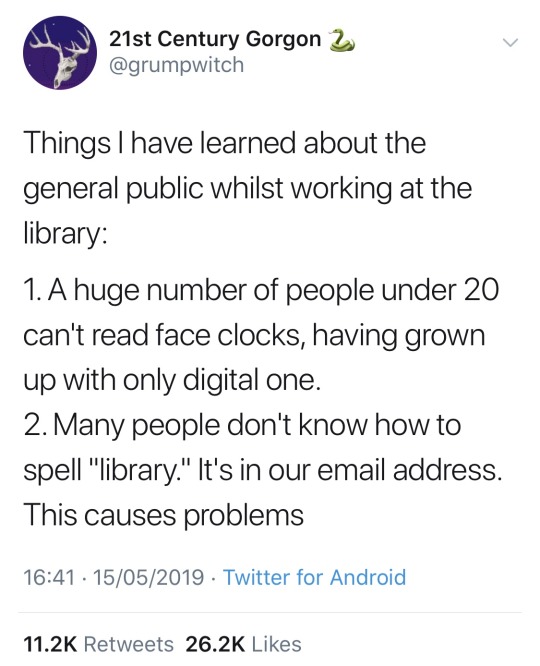
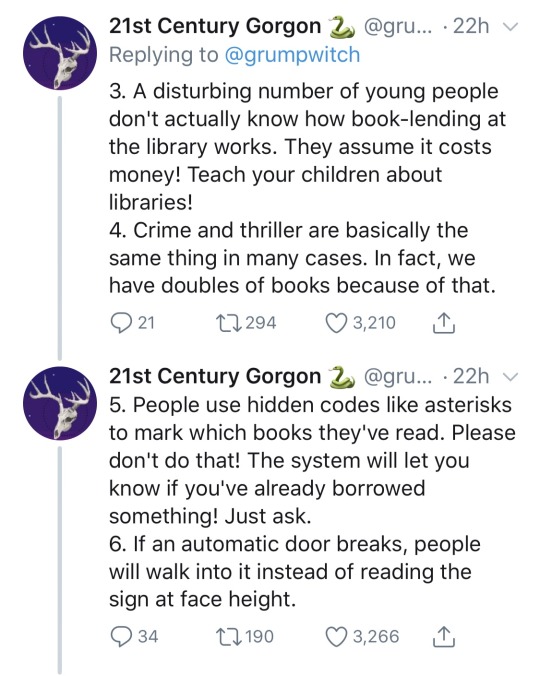
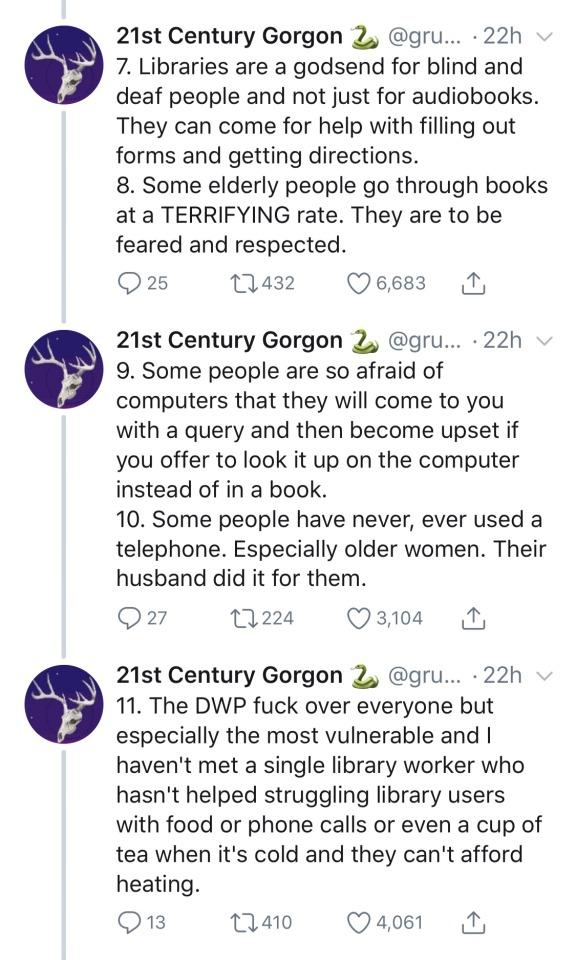

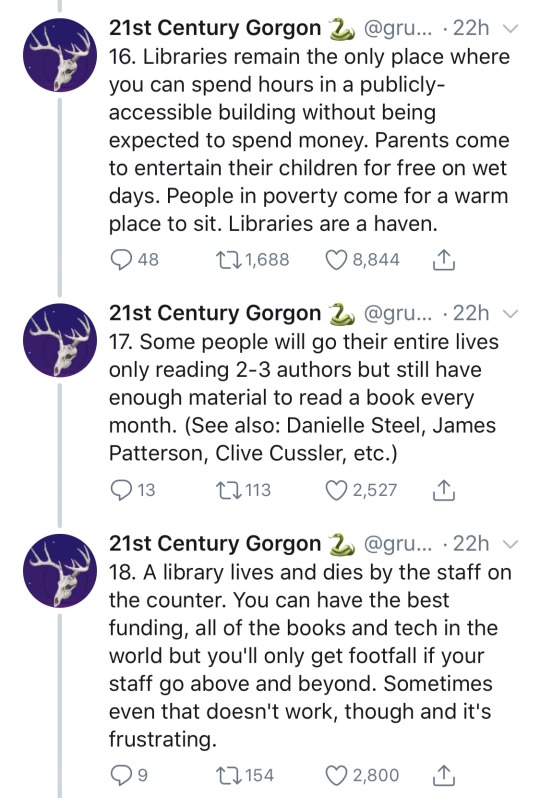
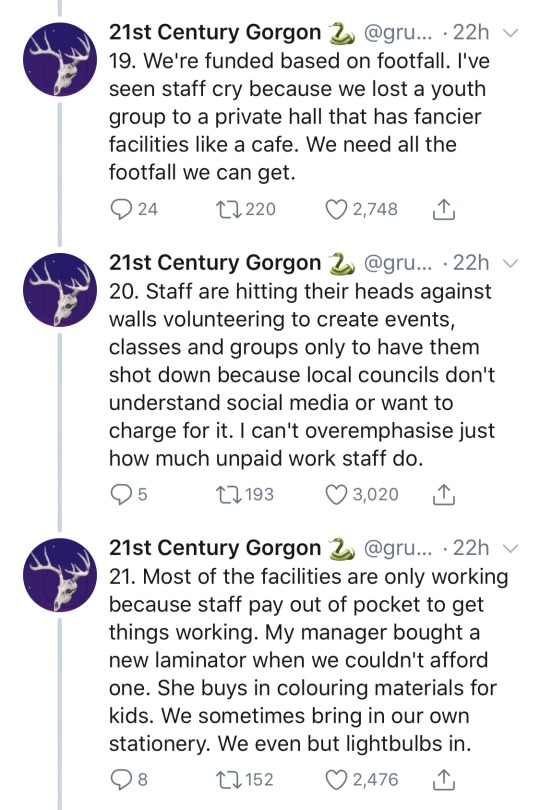
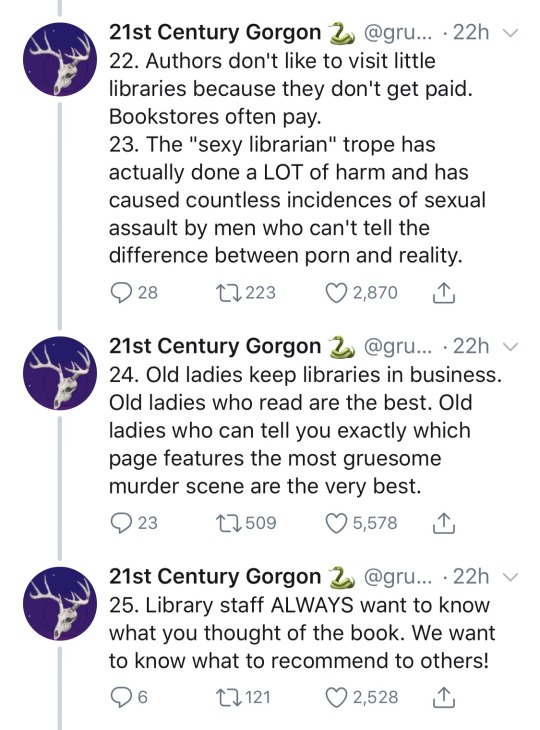
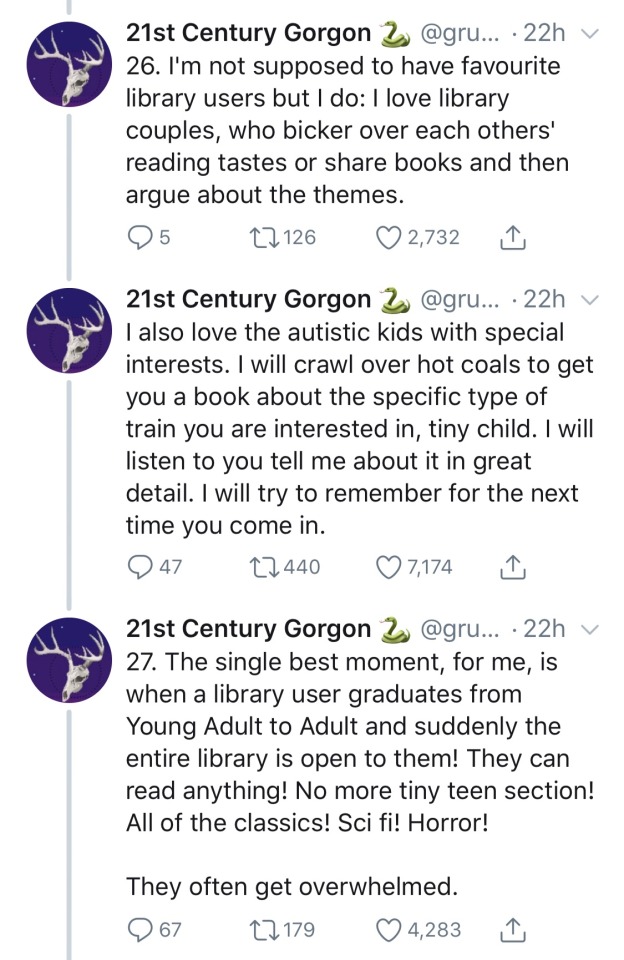
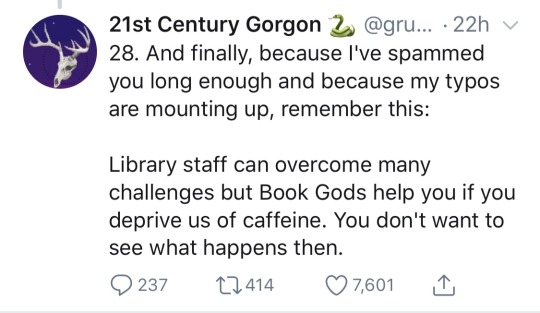
308K notes
·
View notes
Text
Tips to Make Reading Fun – The Best Story App for Kids
In today’s digital age, fostering a love for reading in children has never been easier. With the rise of technology, parents and educators have access to an array of tools that make learning fun and engaging. One such tool is a story app for kids, designed to bring the magic of storytelling right to your fingertips. Why Storytelling is Essential for Kids

Storytelling plays a crucial role in a child’s development. It enhances vocabulary, boosts imagination, and strengthens cognitive skills. A digital library of children's stories provides kids with endless opportunities to explore new worlds, characters, and adventures—all while developing essential reading habits.
Introducing Our App - BiblioStax: Tons of Stories
If you're looking for the perfect learning app for kids, look no further than our Story for Kids app. Designed with both fun and education in mind, this app offers a wide collection of short stories for kids that cater to various age groups and interests.
BiblioStax - A free app full of stories
Android:
iOS:
Key Features of Story for Kids:
Interactive and Engaging Stories – Colorful illustrations and engaging narratives keep children entertained while learning.
Diverse Story Collection – From bedtime tales to moral stories, our app has it all.
Audio Narration – Ideal for early readers, helping kids follow along and improve their listening skills.
Kid-Friendly Interface – Safe, easy to use, and free from distractions.
Offline Reading – Download your favorite stories and enjoy them anywhere, anytime.
Free Access – Enjoy a wide range of stories without any cost.
How to Make the Most of a Story App for Kids
Create a Daily Reading Routine – Set aside 15-30 minutes each day for storytime.
Engage in Discussions – After reading, ask questions about the story to improve comprehension.
Use the Audio Feature – Let kids listen to stories to enhance their pronunciation and listening skills.
Encourage Kids to Retell Stories – This helps in memory retention and builds communication skills.
Explore New Stories Regularly – Keep kids excited by discovering new short stories frequently

Why Choose BiblioStax: Tons of Stories?
Unlike other apps, Story for Kids not only provides an extensive digital library of children's stories, but it also ensures that learning is interactive and fun. Whether it’s for bedtime or learning time, this app for kids' activities is a must-have for every parent looking to nurture their child’s love for reading.
Final Thoughts
The journey of learning starts with stories, and with a story app for kids, you can make that journey magical and enjoyable. Download BiblioStax: Tons of Stories today and unlock a world of imagination and knowledge for your little one!
Start your child’s reading adventure today! Download Story for Kids from the Play Store and explore the joy of storytelling.
1 note
·
View note
Text
Modern Learning: Mohali Schools with Smart Classrooms and Technology
Education is changing fast. Schools in Mohali are using technology to make learning better. Smart classrooms are becoming common. They help students understand topics in new ways.
Why Smart Classrooms Matter
Traditional methods may not always work. Some students need more than books and lectures. Smart classrooms use screens, videos, and interactive tools. These make lessons more engaging.
Students see real-world examples on the screen.
Difficult subjects become easier with visuals.
Learning feels fun and exciting.
Teachers also benefit from technology. They can show live experiments, animations, and presentations. This helps them explain topics more clearly.
Interactive Learning Tools
Smartboards replace chalkboards in many schools. They allow teachers to draw, write, and show videos. Students can touch the screen and interact with lessons.
They solve problems directly on the board.
They play educational games that test knowledge.
They may enjoy learning more than before.
Tablets and computers are also part of smart classrooms. Students use them for research and projects. Digital libraries give them access to many books.
Better Understanding Through Technology
Some students may struggle with theory. Technology helps bring subjects to life. Science experiments are shown through animations. Math problems are solved step by step on the screen.
History lessons include virtual tours of old monuments.
Geography becomes interesting with 3D maps.
Language learning is better with speech recognition tools.
This approach helps students remember concepts. They do not just read but also see and hear.
Online Learning Support
Many schools in Mohali use online platforms. These help students learn even outside the classroom. Teachers upload notes, assignments, and video lectures.
Students can revise at their own pace.
Absent students can catch up easily.
Parents can track progress through apps.
Online tests and quizzes make learning flexible. Students can practice anytime.
Safe and Smart School Environment
Technology is also improving school safety. CCTV cameras are common in Mohali schools. ID cards with tracking help monitor student movement.
Parents feel more assured about security.
Attendance is marked digitally.
Emergency alerts reach parents fast.
Smart buses with GPS tracking are also used. These ensure safe travel for students.
Preparing Students for the Future
The world is moving towards digital careers. Students need to know how to use technology. Schools introduce coding and robotics at an early age.
Kids learn programming in simple ways.
AI and machine learning concepts are introduced early.
Problem-solving skills improve through tech-based learning.
These skills may help students in future jobs. Schools that focus on technology give them an advantage.
Final Thoughts
Smart classrooms make learning better. Top schools in Mohali are adopting modern tools. Students understand concepts better and feel more engaged. Education is not just about books anymore. It is about using the right tools to make learning fun and effective.
Looking for a school with smart classrooms? Mohali has many great options. Choose one that gives your child the best learning experience.
0 notes
Text
Banned Books Club - Book 4: Pet by Akwaeke Emezi

Book Description
"There are no monsters anymore, or so the children in the city of Lucille are taught. Jam and her best friend, Redemption, have grown up with this lesson all their life. But when Jam meets Pet, a creature made of horns and colors and claws, who emerges from one of her mother’s paintings and a drop of Jam’s blood, she must reconsider what she’s been told. Pet has come to hunt a monster—and the shadow of something grim lurks in Redemption’s house. Jam must fight not only to protect her best friend, but also uncover the truth, and the answer to the question—How do you save the world from monsters if no one will admit they exist?
In their riveting and timely young adult debut, acclaimed novelist Akwaeke Emezi asks difficult questions about what choices you can make when the society around you is in denial." - https://www.akwaeke.com/pet
Where It's Banned
Pet by Akwaeke Emezi has been banned in school districts in the following states: Texas, Florida, Iowa, Wisconsin, & Kentucky (2021-2024 school years). https://pen.org/book-bans/pen-america-index-of-school-book-bans-2023-2024/
Why It's Banned
As with many other popular banned books, Pet's main character is a trans girl. According to BookLooks, a tool developed by Moms For Liberty,"this book contains violence including references to child abuse; references to sexual assault; profanity; controversial religious commentary; alternate gender ideologies; controversial commentary on government and society including policing."
Why I Recommend This Book
Stopping children and teens from reading about a character experiencing child abuse does not stop them from experiencing that abuse. Keeping books like Pet away from them can actually make young people feel isolated and less likely to seek help if/when they experience it themselves. This book is a great tool for getting them into the mindset of being able to identify abuse and speak up against it, especially since it addresses the fact that the perpetrators tend to be people the victims know like family or community members. Religion-wise, the book literally describes the biblically accurate depiction of angels in art. Personally, I found that fascinating. The "controversial commentary on government and society including policing" was actually one of the best parts of Pet for me because it shows how folks can become complacent after reaching a sort of equilibrium. The truth of the matter is that the government, society, and police have been violent towards Black folks, especially queer Black folks and we have a right to talk about that. Black children experience this aggression regularly! Not only do I recommend this book, I recommend that guardians and parents take time to talk about it with their kids.
This is a great tool to use for discussions: Educator's Guide.
See how others did the same here:
Exploring Justice through Fiction: Middle School Students Analyze the Book Pet
By Cierra Kaler-Jones
How to Access This Book
The Libby app
This is one of my most used apps on my phone because I can add e-cards from my local library, state library, AND the Queer Liberation Library to check out e-books and e-audiobooks. It is available on browsers, Apple's app store, Google Play, and the Amazon app store.
The Hoopla app
Similar to Libby, I can access e-books and e-audiobooks from my library on here but I can also access films, comics, and music. On Hoopla, we also don't have to wait until another person is done with the book before we borrow it! It is available on browsers, Apple's app store, Google Play, and the Amazon app store.
Books Unbanned
Books Unbanned is a resource is meant to help those who are struggling to access banned books in their states! Brooklyn Public Library founded Books Unbanned in 2022 and now, you can get access through multiple library systems as residents of the US.
The Banned Book Club by DPLA
The Banned Book Club, launched by Digital Public Library of America (DPLA) makes digital versions of banned books available to readers nationwide. The ebooks are available to all readers across the country for free via the Palace e-reader app.
More Resources
Book Résumés - Unite Against Banned Books
Book Résumés help teachers, librarians, parents, and community members defend books from censorship. They detail each title’s significance and educational value and are easy to share with administrators, book review committees, elected officials, and board members.
#books & libraries#books and reading#bipoc books#diverse books#queer books#transgender books#magical realism#YA books
1 note
·
View note
Text
Top Educational Apps Every Parent Should Know About
In today’s digital age, educational apps have become invaluable tools for parents seeking to enhance their children’s learning experiences. From fostering creativity to developing critical thinking skills, these apps cater to kids of all ages and learning styles. Here, we’ve curated a list of top educational apps that every parent should consider.

1. ABCmouse
Age Range: 2–8 years Platforms: iOS, Android, Web ABCmouse is an award-winning app designed to make early learning engaging and fun. Covering subjects like reading, math, science, and art, it offers over 10,000 activities tailored to your child’s learning pace. Parents can track progress, ensuring children stay on track with age-appropriate milestones.

Key Features:
Comprehensive curriculum for young learners.
Interactive games, puzzles, and songs.
Progress tracking for parents.
2. Khan Academy Kids
Age Range: 2–7 years Platforms: iOS, Android Khan Academy Kids provides a wide range of activities to spark curiosity in young learners. With a focus on foundational skills, it covers math, reading, and social-emotional development. The app is completely free and ad-free, making it a parent favorite.

Key Features:
Personalized learning pathways.
Engaging storytelling and animations.
Free access to all content.
3. Duolingo
Age Range: 10+ years Platforms: iOS, Android, Web Duolingo is a fantastic app for kids and adults alike who want to learn a new language. With bite-sized lessons and gamified exercises, it keeps learners motivated and engaged. The app offers lessons in over 40 languages, including Spanish, French, and Mandarin.

Key Features:
Fun, gamified language learning.
Daily streak rewards to encourage consistency.
Audio, visual, and text-based activities.
4. BrainPOP
Age Range: 6–17 years Platforms: iOS, Android, Web BrainPOP is a versatile educational app that covers a wide range of topics, including science, history, and English. Animated videos followed by quizzes make learning interactive and entertaining for kids. It’s a great tool for homework help and supplemental learning.

Key Features:
Engaging, topic-specific animated videos.
Interactive quizzes and games.
Aligned with school curricula.
5. Prodigy Math
Age Range: 6–14 years Platforms: iOS, Android, Web Prodigy Math combines gaming with math practice, making it a favorite among kids. Players embark on adventures, solving math problems to progress through the game. The app aligns with various curricula, ensuring your child’s math skills are on par with school requirements.

Key Features:
Curriculum-aligned math challenges.
Adaptive difficulty levels.
Multiplayer options for social learning.
6. Tynker
Age Range: 7–14 years Platforms: iOS, Android, Web For kids interested in coding, Tynker is an excellent choice. It offers step-by-step coding tutorials, enabling children to create games, animations, and apps. Tynker fosters problem-solving and logical thinking, skills essential for future tech enthusiasts.
Key Features:
Coding courses tailored to age and skill level.
Drag-and-drop programming interface for beginners.
Advanced modules for older learners.
7. Epic!
Age Range: 2–12 years Platforms: iOS, Android, Web Epic! is a digital library offering thousands of books, audiobooks, and educational videos. It’s perfect for fostering a love of reading in children. The app also provides personalized recommendations based on your child’s interests.
Key Features:
Extensive library of books and videos.
Read-to-Me features for younger kids.
Offline access for on-the-go learning.
8. ScratchJr
Age Range: 5–7 years Platforms: iOS, Android ScratchJr introduces young learners to the basics of coding through creative storytelling. Kids can design characters and make them move, jump, and interact by piecing together simple programming blocks.

Key Features:
User-friendly interface for beginners.
Encourages creativity and storytelling.
No reading skills required.
9. National Geographic Kids
Age Range: 6–14 years Platforms: iOS, Android, Web This app brings the wonders of the world to your child’s fingertips. With interactive videos, games, and quizzes, it covers topics like wildlife, geography, and space. It’s perfect for curious kids who love exploring new ideas.
Key Features:
Stunning visuals and videos.
Fun quizzes and puzzles.
Real-world knowledge and facts.
10. Busy Shapes
Age Range: 2–5 years Platforms: iOS, Android Busy Shapes helps toddlers and preschoolers develop problem-solving and fine motor skills. Inspired by the Montessori method, the app encourages exploration and hands-on learning through puzzles and shape recognition activities.
Key Features:
Simple, intuitive design for young learners.
Adaptive difficulty levels.
Encourages independent learning.
Conclusion
Educational apps can be powerful allies in your child’s learning journey. By incorporating these apps into daily routines, parents can create an engaging and interactive educational experience that complements traditional learning methods. Whether your child loves reading, coding, or exploring new languages, there’s an app tailored to their interests and needs.
Start exploring these apps today and watch your child’s curiosity and skills soar!
#momatos.in
#Educational apps for kids#Best learning apps for children#Interactive learning tools#Kids education apps#Early childhood education apps#Coding apps for kids#Language learning apps#Reading apps for children#Math apps for kids#Top educational tools for parents
0 notes
Text
Beyond Homework Help: Creative Ways Parents Can Engage in Their Child's Learning

Parental involvement in a child’s education goes far beyond simply ensuring homework is completed on time. Engaging in creative and meaningful ways can nurture a child’s love for learning, build their confidence, and create a lasting bond between parent and child. Here are some innovative and effective ways to take your involvement to the next level:
CBSE Schools in Coimbatore
1. Turn Everyday Activities into Learning Opportunities
Learning doesn’t have to be confined to textbooks. Everyday activities can become moments of education:
Cooking Together: Teach math and science by measuring ingredients, understanding proportions, and observing chemical reactions while baking or cooking.
Shopping Adventures: Use grocery shopping to teach budgeting, compare prices, or identify nutritious food choices.
Outdoor Exploration: Go for a nature walk and identify plants, insects, or birds. Encourage curiosity by asking open-ended questions.
2. Play Educational Games
Games can make learning enjoyable and interactive:
Board Games: Use games like Scrabble for vocabulary building or Monopoly for understanding financial concepts.
DIY Games: Create trivia questions or scavenger hunts tailored to your child’s school curriculum.
Digital Tools: Introduce age-appropriate educational apps or websites for subjects like math, science, and reading.
3. Foster a Love for Reading
Reading is the cornerstone of learning. Encourage reading habits by:
Creating a cozy reading corner at home.
Visiting libraries or book fairs to let your child pick books that interest them.
Reading together as a family and discussing the story to enhance comprehension.
Encouraging storytelling, where your child creates and narrates their own stories.
Best CBSE Schools in Coimbatore
4. Explore Creative Arts Together
Engaging in arts and crafts can help your child develop creativity and problem-solving skills:
DIY Projects: Build models, paint murals, or create scrapbooks together.
Music and Dance: Explore musical instruments, sing songs, or dance to different genres to build cultural awareness and confidence.
Theater and Role Play: Act out stories or historical events to bring lessons to life.
5. Be a Curious Co-Learner
Show your child that learning is a lifelong journey by participating alongside them:
Watch Documentaries Together: Choose topics that align with their school curriculum or interests.
Learn a New Skill Together: Whether it’s coding, gardening, or learning a new language, embarking on a learning journey as a team is inspiring.
6. Make Field Trips a Family Affair
Take learning outside the home with family outings:
Visit museums, science centers, or historical landmarks.
Explore local farms, factories, or community businesses to understand how things work in real life.
Attend workshops or community classes designed for kids and parents.
CBSE Schools in Coimbatore
7. Support Hands-On Learning Through STEM Activities
Hands-on activities can turn abstract concepts into real-world knowledge:
Build simple science experiments at home, such as making a volcano or growing crystals.
Use building toys like LEGO to teach engineering principles.
Engage in coding activities or simple robotics to prepare for future skills.
8. Encourage Open Communication About Learning
Take time to discuss your child’s experiences at school and beyond:
Ask them about their favorite subjects and challenges they face.
Celebrate their achievements, no matter how small, and motivate them through struggles.
Collaborate with their teachers to align your engagement efforts with their schoolwork.
9. Teach Life Skills Alongside Academics
Academic learning should be paired with essential life skills:
Involve them in household management tasks like planning meals, organizing schedules, or saving money.
Teach problem-solving and decision-making by involving them in family discussions.
10. Model a Passion for Learning
Children mimic what they see. Let them witness your curiosity:
Share something new you’ve learned, whether it’s a fun fact, a skill, or a hobby.
Create a family culture of asking questions and seeking answers together.
Read books or take online courses to inspire their own learning journey.
Best CBSE Schools in Coimbatore
Conclusion
Parental engagement doesn’t have to feel like a chore—it can be a fun and creative way to bond with your child while instilling a love for knowledge. By going beyond homework help and incorporating these ideas into your daily lives, you’re not just supporting their education—you’re helping them become curious, confident, and lifelong learners.
#CBSE Schools in Coimbatore#best cbse schools in coimbatore#Top CBSE Schools in Coimbatore#CBSE schools coimbatore#CBSE Schools in Coimbatore with Low Fees
0 notes